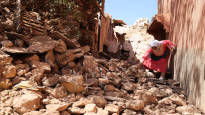You can follow the devastation of natural disasters in the media, but the number of people who died in them has decreased in the century. .
Natural disasters make headlines and their effects are monitored almost in real time. Two major natural disasters have been reported this month.
Almost 4,000 people have died in the floods that arose in the city of Derna in Libya, and almost 3,000 people have died in the 6.8 magnitude earthquake in Morocco.
The earthquake in Morocco is characterized as the most destructive in 120 years.
In the news stream, it seems that natural disasters happen more often and more people die in them than before. However, the statistics tell otherwise.
At the beginning of the 20th century, natural disasters such as floods, earthquakes, volcanic eruptions and droughts killed around half a million people a year.
Of these numbers, the number of fatalities has decreased to well under half over the past hundred years.
For example, in the 2010s, an average of just under 100,000 people died in natural disasters per year. Among the most destructive of the decade is the earthquake in Haiti, which killed up to 300,000 people in 2010.
The natural disaster that claimed the most lives in modern history took place in 1931. At that time, the level of China’s three largest rivers, the Yangtze River, the Huai River, and the Yellow River, rose exceptionally high as a result of heavy rains and melting snow.
In these floods an estimated two million people died. According to some estimates, the death toll may be as high as four million.
Heat-related Deaths delayed in statistics
Senior researcher Damien Delforge works at the Center for Research on the Epidemology of Disasters (CRED) in connection with the Belgian University of Louvain, which studies natural disasters.
He, too, has noticed a decrease in the number of fatalities, although he emphasizes in the same breath that the cause-and-effect relationships are complicated.
– In general, there seem to be fewer fatalities. However, it is easy to check the temperature on the meter, but more difficult to find out the effects of the weather, says Delforge.
Damien Deforge takes second place, for example, for the development of recent years the intense heat brought by climate change. Heat-related Deaths occur with a delay. That’s why the statistics are updated all the time.
– According to preliminary data, there were 16,000 heat-related deaths in Europe in 2022. The updated figures bring the number of deaths to around 60,000, Delforge explains.
In the CRED center, the huge amount of material is analyzed, for example the frequency of occurrence and victims of natural disasters. From individual natural disasters, the number of earthquakes seems to be increasing.
Preparation reduces deaths
There are several explanations for the drop in the number of victims.
Improved telecommunication connections, for example satellite images, quickly provide information on the geographical extent of disasters and partly facilitate rescue work. The casualty figures will be more detailed as the rescue work progresses.
The accuracy of alarm systems has also improved and, for example, tsunami warnings are commonly used in Asian sea areas, for example. Although population growth has accelerated, the standard of living has improved and medicines have developed. Even a hundred years ago, for example, tuberculosis and diseases caused by dirty drinking water killed people.
